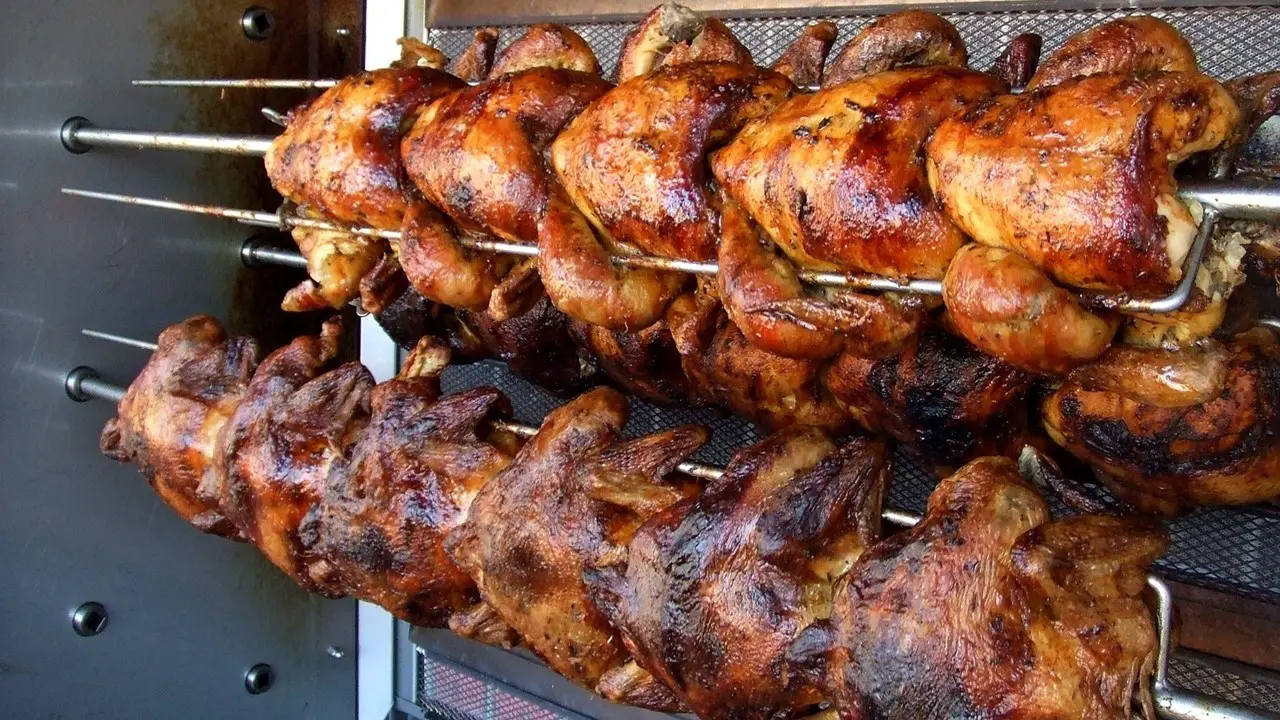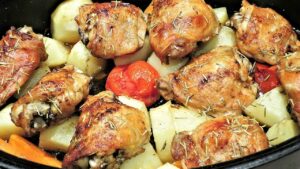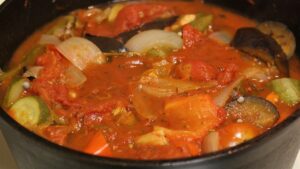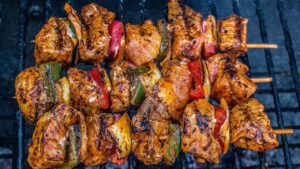What is Rotisserie?
Rotisserie, also known as spit roasting, is a classic cooking technique that has been used for centuries. It involves skewering meat on a long, solid rod and cooking it over an open flame or in an oven.
While traditionally used for whole animals such as pigs and turkeys, this method is also great for large cuts of meat.
The rotating spit ensures that the meat is evenly cooked and bastes itself in its own juices, resulting in a succulent and flavorful dish.
This method of cooking is not only practical, but it also adds an element of spectacle to any gathering or event.
Key Takeaways
- Rotisserie is a method of cooking that uses a particular piece of equipment to slowly rotate meat on a rotating cylinder to cook it.
- Rotisserie ovens use advanced engineering to ensure even cooking.
- Vertical rotisserie allows restaurants to serve meat straight off the spit or chicken pieces packaged for takeout.
Understanding Rotisserie

The spit was the go-to method for cooking meat in a big household in early modern and medieval cuisine.
The food was cooked by a servant, preferably a boy, who sat close to the spit and turned a metal rod slowly; this person was referred to as the “spit boy” or “spit jack.”.
Later, mechanical turnspits (also known as “roasting jacks“) were developed, initially propelled by dogs on treadmills, and later by steam and mechanical clockwork mechanisms.
The spit could also be run by a chimney-mounted turbine that converts torque and speed using a worm transmission. Electric motors are now frequently used to power spigots.
The term “rotisserie” can also refer to a mechanical cooking tool or a venue that specializes in spit-roasted meat. The word originates from French, where it first appeared in Parisian shops around 1450.
You get all the advantages of direct grilling without the flare ups when you use your rotisserie to cook.
It offers a crisp exterior and you also get to enjoy juicy meat which is just below the surface, as this method increases water retention rather than drying up the meat.
Food on a rotisserie is basted from the inside out, which is one of the most frequently heard criticisms of this method of cooking.
This is true because the juices and fat inside are rendered and released as the food cooks in a convection-style fashion from the outside in, drizzling over the rotating food as it spins.
The indirect heat source, such as a rear rotisserie burner or bottom burner, is warming the outside of the food as you cook, such as a roasting chicken.
To cook the deeper meat, the heated outside of the meat is transferring heat inside. This deliberate low-speed motion smoothly renders the fat.
The collagen in the meat is kept from rapidly contracting thanks to the leisurely rendering and slow roasting.
The collagen is broken down and more water is absorbed by it as a result of the slow heat, resulting in gelatine.
This plays a crucial role in creating a meal that is tender and juicy, especially when combined with melting fat.
These juices are then expelled from the meat and drip delicious fats and flavourful liquids over the rotating surface, basting the food you are cooking.
Types of Rotisseries
There are mainly two types of Rotisseries: Horizontal Rotisserie and Vertical Horizontal Rotisserie.
Horizontal Rotisserie
A horizontal rotisserie is a method of cooking that uses a particular piece of equipment to slowly rotate meat on a rotating cylinder, or “spit,” to cook it.
The more archaic cooking methods that involved turning a stick over a fire gave rise to the modern rotisserie oven. Modern rotisserie ovens use advanced engineering to ensure even cooking.
Buyers of these ovens can find them in a range of sizes to accommodate residential or commercial use, as well as with features like timers to further aid in the optimized cooking of a piece of meat.
One advantage of the horizontal rotisserie is that it can be used to roast whole animals while retaining most of the internal juices.
In general, the internal juices will circulate throughout the meat as it rotates on a spit, assuming the animal is whole and the skin is still intact.
Whole chickens are frequently cooked in this manner for use in restaurants or for resale. This method of slow cooking is popular for many types of birds, especially chicken.
A horizontal rotisserie allows restaurants to serve whole birds straight off the spit or chicken pieces packaged for takeout. Meat that is left over can be used in other dishes.
Additionally, the extra skin, which is seared while the meat cooks, benefits from the horizontal rotisserie’s crispiness.
One of the reasons the horizontal rotisserie has become so well-liked is the combining of the skin’s crisp outer layers and juicy interior.
Vertical Rotisserie
Although it goes by many names, the vertical rotisserie typically consists of sizable pieces of meat that are pieced or sliced together from a base of meat.
Then, a vertical spit is used to hold these portions of meat. To make sandwiches and other menu items for restaurants, chefs typically shave off smaller pieces of the meat.
Importance of Rotisserie
When compared to traditional grilling, rotisserie grilling has many benefits. Listed below are important reasons why you must pick rotisserie as a method of cooking:
Easy to Use
Utilization is simple because rotisserie grills don’t need specialized training or tools.
Large cuts of meat can be simply browned without burning on the grill as long as they can support a rotisserie attachment.
Also great for maintaining a constant cooking temperature are gas rotisserie grills.
You can have a perfectly cooked cut of meat in a few hours by simply putting the meat on the spit, turning the spit, and setting the grill’s heating element to the desired temperature.
No Risk of Burning
When cooking with a rotisserie grill, the meat rotates continuously as it cooks, ensuring that it is evenly browned all over.
This method of cooking eliminates the risk of burnt spots or flare-ups, making it a convenient option for cooking meat.
Does Not Need Continuous Monitoring
When you cook meat on a rotisserie, it not only evenly browns, but also bastes itself while cooking, reducing your work.
As the meat rotates on the spit, its outer juices accumulate and are cooked by the heat source, creating a deliciously flavorful crust.
This also seals in the juices, resulting in moist and tender meat.
Whether it’s a roast or a whole chicken, cooking on a rotisserie is a great way to get a perfectly cooked and flavorful dish with minimal effort.
A Healthy Method of Cooking
One of the main benefits of using a rotisserie grill is that it uses less fat and grease.
Rotisserie grilling is a great option for people who want to cook outside but still eat healthy food because any extra grease and fat drip off the meat you’re cooking.
Tips to Make Rotisserie Better
Rotisserie is a delicious and popular way of cooking meat that has been enjoyed for centuries.
Whether you are a seasoned rotisserie pro or a beginner, there are always ways to improve your technique and create even more succulent and flavorful dishes.
Here are some tips to make your rotisserie cooking even better:
Choose the Right Cut of Meat: To get the most out of your rotisserie, it’s essential to choose the right cut of meat.
While whole animals such as pigs and turkeys are often roasted on a spit, large cuts of beef, lamb, and pork are also great choices.
Look for cuts with a good amount of fat marbling, which will keep the meat moist and tender as it cooks.
Marinate the Meat: Marinating your meat before cooking it on the rotisserie can add an extra layer of flavor and help to tenderize the meat.
Use a marinade that complements the type of meat you are cooking and let it marinate for several hours or overnight for best results.
Truss the Meat: To ensure even cooking and prevent the meat from falling off the spit, it’s important to truss it tightly with kitchen twine. This will help to keep the meat in place and prevent it from slipping as it rotates.
Use a Thermometer: To ensure that your meat is cooked to perfection, use a meat thermometer to check the internal temperature.
For most cuts of meat, a temperature of 145°F is considered safe, but check the specific guidelines for the type of meat you are cooking.
Baste the Meat: Basting the meat with its own juices as it rotates on the spit can help to keep it moist and flavorful. You can also brush it with a mixture of oil and herbs or other flavorings to add even more flavor.
Let it Rest: After the meat has finished cooking, let it rest for 10-15 minutes before carving. This will help to redistribute the juices throughout the meat and make it even more tender and flavorful.
Experiment with Different Flavors: Don’t be afraid to experiment with different flavors and seasonings to create unique and delicious dishes. Try using different spices, herbs, and marinades to add a new twist to your favorite cuts of meat.
At the end, these tips can help you to take your rotisserie cooking to the next level and create mouth-watering dishes that will impress your friends and family.
Whether you are a novice or an experienced cook, there is always room to improve your technique and create even more delicious and flavorful meals.
Uses of Rotisserie in Indian Cuisine
Rotisserie is a versatile cooking tool that is widely used in Indian cuisine.
It is a popular method of cooking in many Indian households and restaurants, and it is used to prepare a variety of dishes.
Here are some of the most common uses of rotisserie in Indian cuisine:
Tandoori Chicken: Tandoori chicken is a popular dish in Indian cuisine that is made using a rotisserie.
The chicken is marinated in a mixture of yogurt and spices, and then skewered onto the rotisserie. It is then cooked over a charcoal fire until it is tender and juicy.
Seekh Kebabs: Seekh kebabs are another popular dish that is made using a rotisserie. These kebabs are made from minced meat that is seasoned with spices and then formed into long, thin sausages.
The sausages are skewered onto the rotisserie and then cooked over a charcoal fire until they are crispy and golden brown.
Shawarma: Shawarma is a Middle Eastern dish that has become popular in India in recent years.
It is made by skewering strips of marinated meat onto a rotisserie and then slowly cooking it until it is tender and juicy.
The meat is then sliced thinly and served in a pita bread with vegetables and sauces.
Conclusion
The most popular method of grilling food is still the rotisserie.
You should be aware that when using this technique, the meat does not grill but rather roasts, absorbing the flavor of the smoke and acquiring a crisp, perfectly cooked crust.
The most essential component of this method is patience, but you will see that it pays off.







